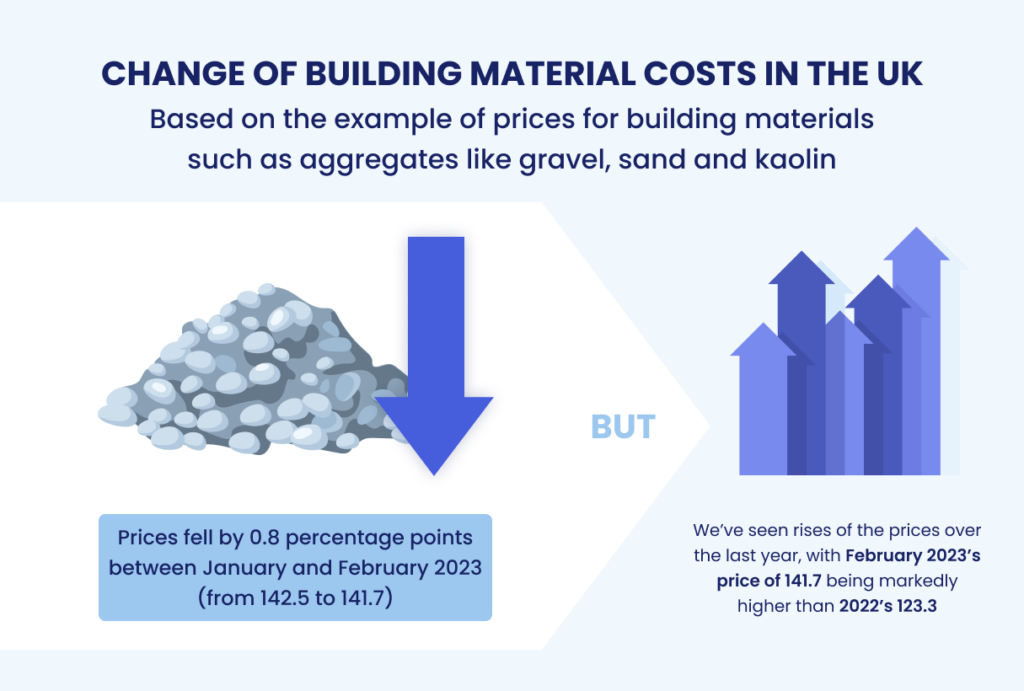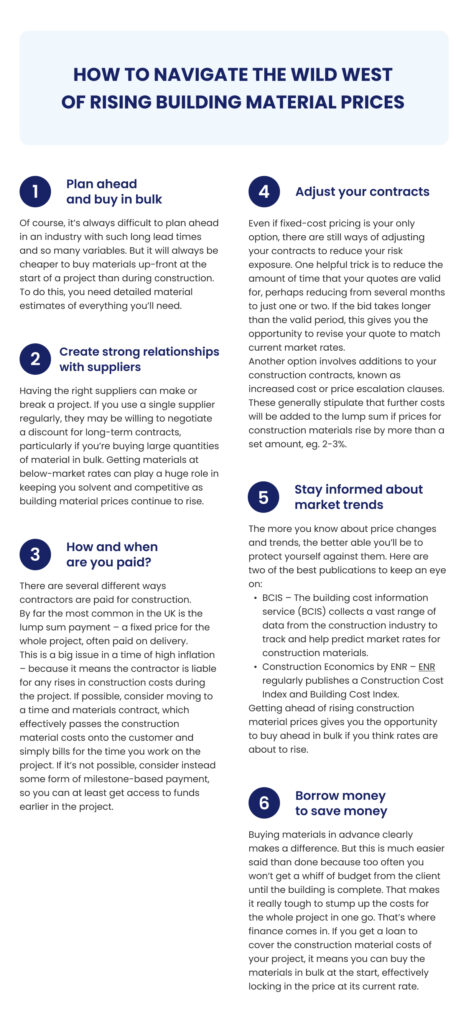Construction Tips, News & Best Practices
How to Navigate Rising Building Material Prices in the UK (2023)

Danny Mitchell
Head of Content Marketing
We take a deep dive into the world of rising building material prices and consider how you can stay profitable in an uncertain market.
We also ask the question: When will building material costs go down in the UK?
Inflation: It’s the word on everybody’s lips and it’s not going anywhere.
Prices are rising across the economy, and the construction industry is no different.
Building material prices have shot up over the last 12 months, which means contractors everywhere are having to cut costs.
It might seem like contractors are powerless in the face of construction material cost rises: But there are steps you can take to reduce your exposure.
We discuss what you need to do to keep your books and profit margins intact.
When will building material costs go down in the UK?
Tl;dr: Construction costs may be falling slightly, but don’t get your hopes up.
Over the last year, UK building costs rose enormously.
In recent months, these rises have begun to slow as inflation and energy prices reach their peak.
This has led many to ask, “When will building material costs go down in the UK?”
It’s important to stress that slower inflation doesn’t mean falling costs – it just means they’re rising less quickly than before.
Prices for building materials in the UK, therefore, remain at or near their peak - much higher than they have been for years.
But there are tentative signs this is beginning to change.
According to recent government month-on-month figures, construction material costs remained level or dropped slightly between January and February this year.
An example: prices for building materials such as aggregates like gravel, sand and kaolin fell by 0.8 percentage points in this period (excluding the aggregate levy), from 142.5 to 141.7.
(This model uses 2015’s rates as the baseline of 100, with each subsequent year being a percentage rise in comparison).
Crucially, however, whatever price falls we’ve seen in previous months don’t make up for rises we’ve seen over the last year, with February 2023’s price of 141.7 being markedly higher than 2022’s 123.3.

This trend is similar across most materials, with construction costs having risen markedly over 2022 and then slowing, or even reducing slightly, over the last few months.
But in almost all cases, this doesn’t come anywhere close to reversing the rises we’ve seen over the last year – and there’s no guarantee building material prices will continue to fall.
How to navigate the wild west of rising building material prices
In construction, inflation is even more of a challenge than in other industries.
This is a sector in which projects already take months or years to complete - and have razor thin profit-margins for constructors.
Here are some tips to help you better manage your construction costs:
-
Plan ahead and buy in bulk
Easier said than done, you might say – this is construction, after all…
Of course, it’s always difficult to plan ahead in an industry with such long lead times and so many variables.
But it will always be cheaper to buy materials up-front at the start of a project than during construction.
To do this, you need detailed material estimates of everything you’ll need. Check out our recent post on construction estimating basics to learn how to do this.
-
Create strong relationships with suppliers
Having the right suppliers can make or break a project. If you use a single supplier regularly, they may be willing to negotiate a discount for long-term contracts, particularly if you’re buying large quantities of material in bulk.
Getting materials at below-market rates can play a huge role in keeping you solvent and competitive as building material prices continue to rise.
“I have found that establishing strong relationships with suppliers is crucial to obtaining better pricing and mitigating the impact of price fluctuations.
“By developing long-term partnerships with suppliers, I have been able to negotiate long-term contracts with fixed prices, reducing the uncertainty of material costs.”
Danny Mitchell, Archdesk Head of Content and former Construction Estimator
-
How and when are you paid?
As we discussed in a recent article about invoicing and billing, there are several different ways contractors are paid for construction.
By far the most common in the UK is the lump sum payment – a fixed price for the whole project, often paid on delivery.
This is a big issue in a time of high inflation – because it means the contractor is liable for any rises in construction costs during the project.
If possible, consider moving to a time and materials contract, which effectively passes the construction material costs onto the customer and simply bills for the time you work on the project.
Clients will be understandably hesitant about agreeing to this – for much the same reason that you don’t want to be paid a fixed lump sum: it’s effectively a blank cheque.
If it’s not possible, consider instead some form of milestone-based payment, so you can at least get access to funds earlier in the project.
-
Adjust your contracts
Even if fixed-cost pricing is your only option, there are still ways of adjusting your contracts to reduce your risk exposure.
One helpful trick is to reduce the amount of time that your quotes are valid for, perhaps reducing from several months to just one or two.
This helps protect you from price rises between bidding and winning the project – a period which often takes several months.
If the bid takes longer than the valid period, this gives you the opportunity to revise your quote to match current market rates.
Another option involves additions to your construction contracts, known as increased cost or price escalation clauses.
These generally stipulate that further costs will be added to the lump sum if prices for construction materials rise by more than a set amount, eg. 2-3%.
Generally, these will be subject to negotiation, and you’d be lucky if you managed to pass all rises in construction material prices onto the customer.
But as ever, every reduction helps, and it’s definitely worth seeing what wiggle room your client will allow.
-
Stay informed about market trends
Another key tactic here is to try and position yourself ahead of the market.
The more you know about price changes and trends, the better able you’ll be to protect yourself against them. Here are two of the best publications to keep an eye on:
- BCIS – The building cost information service (BCIS) collects a vast range of data from the construction industry to track and help predict market rates for construction materials.
- Construction Economics by ENR – ENR regularly publishes a Construction Cost Index and Building Cost Index.
Getting ahead of rising construction material prices gives you the opportunity to buy ahead in bulk if you think rates are about to rise.
“To better predict material price fluctuations, I make a point of staying informed about market trends and economic indicators. Subscribing to industry newsletters and using material pricing databases is invaluable for staying up-to-date on current prices and trends.”
Danny Mitchell, Archdesk Head of Content and former Construction Estimator
-
Borrow money to save money
Buying materials in advance clearly makes a difference.
But this is much easier said than done because too often you won’t get a whiff of budget from the client until the building is complete.
That makes it really tough to stump up the costs for the whole project in one go. That’s where finance comes in.
Contractors are understandably wary about pursuing finance for projects – but if used right, it can be a key tool in your arsenal.
If you get a loan to cover the construction material costs of your project, it means you can buy the materials in bulk at the start, effectively locking in the price at its current rate.

Contractors vs. inflation: A struggle for survival
The construction industry, like much of the UK economy, is going through a tough time – but there’s every chance this could start to change across 2023.
As we discovered, there are signs that building material prices have fallen and may continue to do so over the next few months.
And across the board, the rises have clearly hit their peak and seem to be going up now at a much slower rate.
So, all things being well, the situation could well pick up in the coming months.
Until then, buckle up.
If you want to find out more about how Archdesk can help you deal with rising construction material prices, check out our budget control features here.
Frequently Asked Questions (FAQs)
Are building material costs coming down?
Building material costs rose sharply across 2022, and are now levelling out or, in some cases, reducing very slightly. However, prices are unlikely to return to their pre-2022 levels any time soon, if ever.
What are the best practices for dealing with rising building material costs?
The best practices for dealing with rising building material prices are:
- Buy ahead and in bulk where possible
- Create strong relationships with suppliers
- Move to a price and materials model if possible
- Consider your contractual clauses
- Stay informed about market price trends
- Consider finance for projects
What will happen to property prices in 2023?
Property prices in the UK have risen marginally in comparison to 2022, though not as much as in recent years. Due to rises in interest rates, these price rises are expected to slow or even fall in the coming months.
You might also like
February 29, 2024 • 7 min read
Utilizing the human-first approach to construction projects to drive higher results.
July 3, 2023 • 6 min read
8 Best Construction Drawing Management Software (2023): A Comprehensive Guide
Find all the information you need about the construction drawing management software tools available on ...June 14, 2023 • 6 min read
The 11 Best PlanGrid Alternatives (2023)
Looking for a great alternative to PlanGrid software? Check out the 11 best construction software tools ...June 14, 2023 • 4 min read
How to win at CIS 340 and make taxes a breeze
CIS 340 is a legal obligation for contractors. But getting it right isn’t straightforward. Want ...




